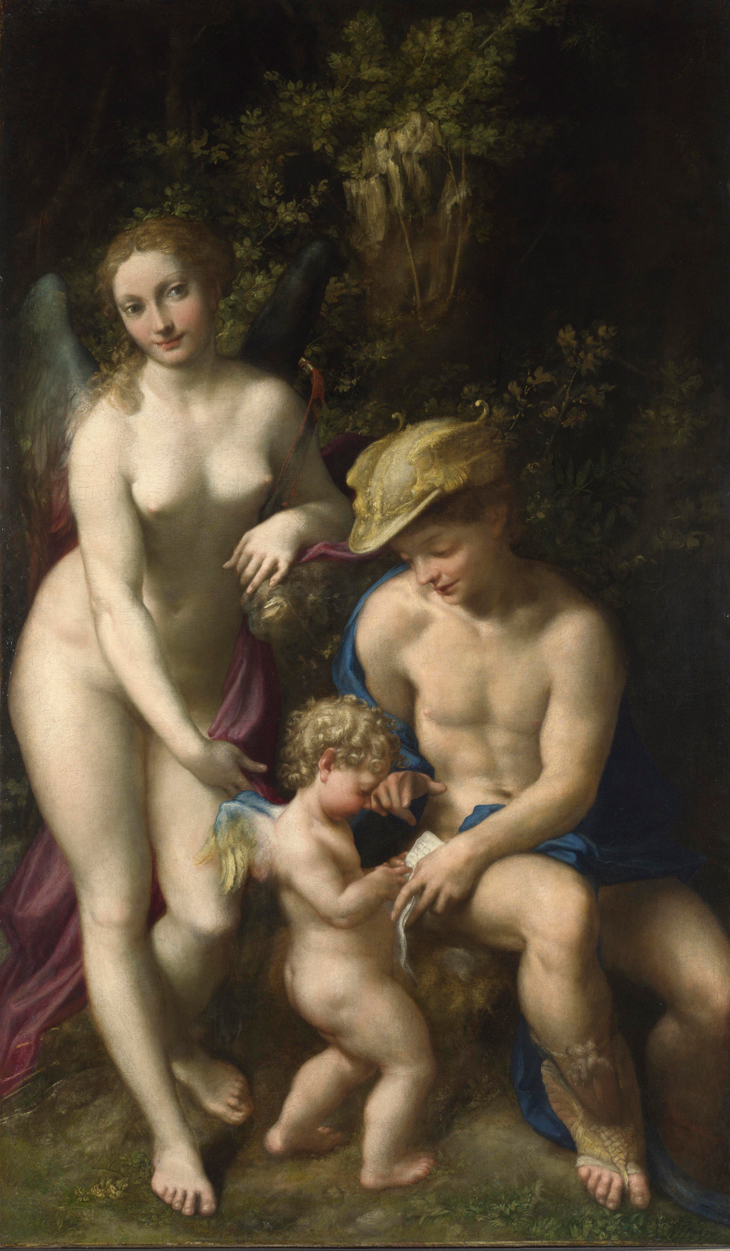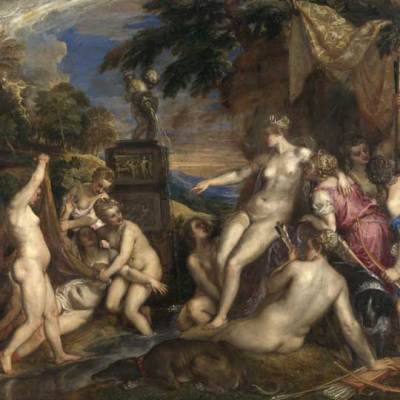Exploring Whitehall Palace in London in the 1630s would have been an exhilarating experience. Consignments of Titians and Raphaels had arrived from Italy and their display was complemented by Van Dyck’s brilliant new portraits, which crystallised the sophisticated image of Charles I’s court. The subsequent cataclysm of the Civil War, execution of the king in 1649, and dispersal of his collection might lead you to believe that this glittering moment of collecting and patronage could never be recaptured. However, the Royal Academy of Arts and the Royal Collection Trust have made an impressive attempt to prove such a conclusion wrong, and the result is one of the most ambitious and engrossing exhibitions mounted in many years.
Charles I’s collection was formed through a combination of inheritance, competition and opportunity. He was inspired by his immediate circle – the enthusiasms of his mother Anne of Denmark and older brother Prince Henry, who was a precocious connoisseur, as well as the taste of his Catholic wife Henrietta Maria. The courtiers who hovered around the king – the earnest Earl of Arundel, capricious Duke of Buckingham and opportunistic Duke of Hamilton – also spurred on his acquisitive ambitions, making the business of collecting a competitive game as well as a measure of wealth and knowledge. A reckless visit to Spain while he was Prince of Wales also proved seminal. In 1623 Charles travelled to Madrid to secure an infanta-bride; politically the trip was a farce, but artistically it proved a revelation, as it allowed him to admire the great Spanish Habsburg collection, crowned by the achievements of Titian.
The Supper at Emmaus (c. 1534), Titian. Photo: Stéphane Maréchalle; © RMN-Grand Palais (musée du Louvre)

The outstanding opportunity to match such continental magnificence at home came in 1627 with the king’s chance to acquire the Gonzaga collection from Mantua, which included a heady mix of works by Mantegna, Correggio, and Caravaggio, as well as long-desired Titians and Raphaels. Such a coup was possible only because of the existence of an international network of agents and diplomats whose achievement underpinned the thirst for classical and Renaissance art in Stuart London. The collection Charles built through employing their skills was meticulously documented in 1639 by his Surveyor Abraham van der Doort; it consisted of about 2,000 works, a quarter of which were sculptures. To evoke its breadth and quality 140 loans have been selected for the current exhibition, the majority from the Royal Collection, complemented by major paintings from the collections of the Louvre, Prado, National Gallery and the Frick.
Venus and Mercury and Cupid (‘The School of Love’) (c. 1525), Correggio. National Gallery, London

The installation is elegant, restrained and carefully paced, and allows for moments of great spectacle as well as more intimate looking. Splendour on a large scale is summoned up by the presence of Mantegna’s Triumphs of Caesar cycle of tempera paintings. Made for the Duke of Mantua, it was last moved from Hampton Court to the Academy in 1992 for the great Mantegna exhibition. A similar sense of the grand enrichment of the court is achieved through the inclusion of four Mortlake tapestries from the Mobilier national, Paris. These were created using Raphael’s Sistine Cartoons, which Charles had acquired from Italy; it is fitting that the cartoons themselves were not however moved from the Victoria and Albert Museum, where they are on permanent loan, but represented by tapestries, as the king would undoubtedly have viewed them merely as the source for such prestigious works, rather than drawings to be admired in their own right.
At the heart of the exhibition is a terrific piece of theatre: the bringing together of the three monumental Van Dyck equestrian portraits of Charles (Royal Collection; Louvre National Gallery). Never intended to be seen like this, their relative merits – and varied conservation histories – can be judged for the first time. The Louvre’s painting, with its sitter’s insouciant pose, its animated landscape, and its miraculous passages of silvery silk and plush red velvet, is perhaps the most successful and its presence is arguably the greatest coup of the show.
Charles I (‘Le Roi à la chasse’) (c. 1635), Anthony Van Dyck. Musée du Louvre, Paris. Photo: © RMN-Grand Palais (musée du Louvre)/Christian Jean

On a smaller scale, the Royal Collection’s triple portrait of the king by Van Dyck is the image which perhaps gives us the clearest sense that we might come close to knowing something of his deep enthusiasm for great art, as well as his hauteur, rigidity of belief and doleful elegance. A hallucinatory picture, it was dispatched to Rome for Bernini to use as a source to sculpt his portrait of Charles, which, tragically, was later destroyed. It is possible to imagine the collector-king as characterised here earnestly admiring and handling virtuosic treasures in his private Cabinet Room, where a magnificent ancient cameo of the Emperor Claudius, a Francesco Fanelli bronze or an Isaac Oliver miniature could all be seen. The gallery dedicated to such experiences is beautifully installed and likewise encourages close study.
Throughout the exhibition there are moments of great interest. These include the clever juxtaposition of the Roman marble Crouching Venus with Rubens’ Peace and War, which eloquently conveys how ancient art was a key source for 17th-century creativity; the reuniting of Orazio Gentileschi’s sensual Old Testament canvases that once hung in the Queen’s House; and the somewhat surprising enthusiasm the king evidently had for northern Renaissance art, illustrated by the works of Bruegel, Holbein and Massys among others, which acts as a fascinating counterpoint to his more well-known Italianate passions.
The Three Soldiers (1568), Pieter Bruegel the Elder. The Frick Collection, New York

One of the consequences of this remarkable exhibition is that it makes you consider afresh the impact of Charles I’s collecting and patronage; it of course inspired Charles II at the Restoration, but also, later, the enthusiasms of George IV. The king’s commissions for Rubens and, in particular, Van Dyck were to prove liberating for painters in Britain – as Lely, Gainsborough, Lawrence and Sargent were all heirs to them. Aside from such issues of inheritance, what is also commemorated here is a key moment at which London was becoming a truly cosmopolitan capital and embraced the culture of Europe; to be reminded of the benefits of this in such a majestic fashion is especially thought-provoking now.
‘Charles I: King and Collector’ is at the Royal Academy, London, until 15 April.
From the March issue of Apollo. Preview and subscribe here.



